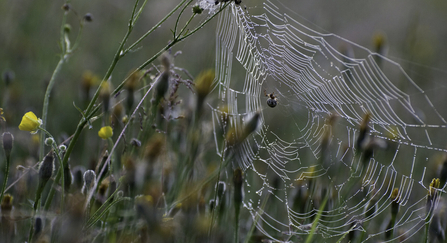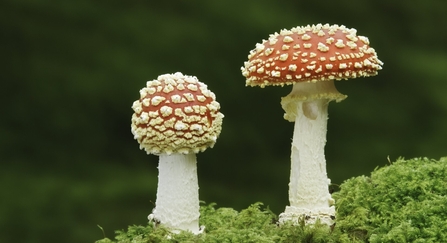One of the best things about autumn is spiders. Not everyone is a fan of the beasties themselves, but a dew-spangled or frosty web in the hedge or window frame is a beautiful sight. Of course, spiders build webs all year round (not just for Hallowe’en), but this is when they’re most visible, when their transparent silk is highlighted. The picture-book webs are made by orb-weaver spiders, the best-known of these being the garden cross spider; this species is common in a wide variety of habitats. Each web can be as much as 40cm across, and takes the weaver around 2 hours to build.
Dr Cath’s Nature Notes – October
Autumn leaves (c) Katrina Martin / 2020VISION

Zsuzsanna Bird
House spiders are fully grown at this time of year, and actively seeking mates, so are more likely to be visible around our homes, perhaps sprinting across the floor or trapped in the bath or basin. Some grow particularly large – Tegenaria parietina can have a leg-span of as much as 17cm, and can be a rather alarming house-guest, despite being completely harmless and even helpful as they hoover up insect pests. Their webs are much less attractive, forming large sheets of closely woven silk. Several generations of spider may refurbish the webs, which can grow to considerable size and dustiness if undisturbed – truly the stuff of horror movies!
That spider that appears on your hearthrug every evening, stopping its scurrying halfway across to eye you up really isn’t interested in you. He’s following his nightly rounds, hoping to find a female spider. As spiders are easily tired, he’s just pausing for breath. If spiders find themselves in a bathtub during their quest, they get trapped by the smooth sides – if you object to their presence or just want to save them the stress, leave a towel or length of toilet paper hanging over the side and into the bath to provide an escape route.

Fly Agaric (Amantia muscaria) Guy Edwardes/2020VISION
Outside, the autumn colours are beginning to show as leaves turn colour and berries brighten the hedgerows. Leaf colour is affected by frost, so for a good show we should hope for early frosts and clear days. Head out to your nearest deciduous woodland or just enjoy the sights as you travel through the county. A walk in the woods offers the best of the autumn fungi – fly agarics brightening the ground beneath birches, strange earthstars, tempting ceps and spectacular bracket fungi. It’s strange to think these are merely the ‘fruits’ of vast, spreading, underground organisms which connect up the whole of the woodland and are vital to the health of the entire ecosystem. Most fungi are saprotrophs – decomposers. They feed on decaying organic matter and return its nutrients to the soil. As the only organisms able to break down wood and the cellulose in plant cells, fungi are the primary decomposers in forests, as well as being sometimes spectacularly beautiful – well worth hunting out. Take a good field guide or a spotter sheet, and see how many different types you can find.
October is the first month we usually see winter migrant thrushes such as fieldfares and redwings coming in. Cold weather in their northern breeding grounds triggers their exodus, so watch out for them arriving on a cold northerly wind. Redwings migrate by night, and may be heard calling to each other as they pass overhead in the darkness. Keep an eye on hawthorn hedges, where a good berry crop will attract newly arrived migrants. Winter wildfowl will be appearing too, so I shall be heading out to our new hide at Sinker’s Fields in Whixall to watch out for widgeon, shovelers, teal, goldeneyes and geese. Hen harriers and short eared owls are other winter visitors to the mosses; at this time of year there’s always the excitement of when the first will drop by. Winter waders such as golden plover, large flocks of lapwing, redshanks, ruff and godwits also haunt wetlands – try Wood Lane or Venus Pool for a chance to see these.
As the nights get longer and colder, don’t forget to keep your garden birdfeeders well stocked up, perhaps adding some calorie-rich treats such as fat balls or peanut butter (the kind made especially for birds). Watch out for hedgehogs too – any that appear to be particularly small or underweight may need a helping hand going into hibernation. Put out some meaty cat or dog food, or tinned or dry hedgehog food, and leave leaf or brash piles in your garden to provide possible hibernation sites. Any autumn bonfires should be checked for sleeping inhabitants before lighting – I prefer to move the pile to a new site, just in case. And please remember – don’t be too tidy! Leave seed heads and dead vegetation to give those important garden predators somewhere to overwinter, so they can do a good job controlling garden pests next year.

